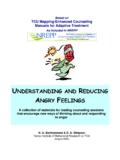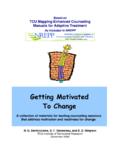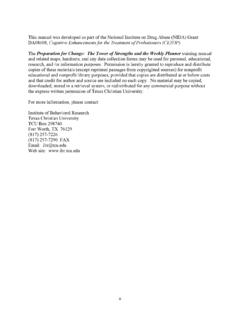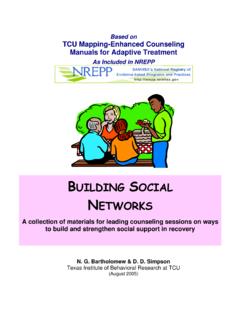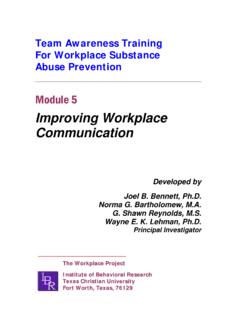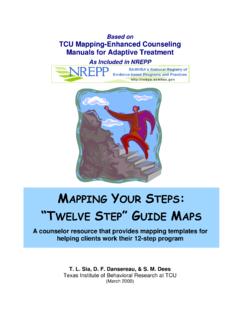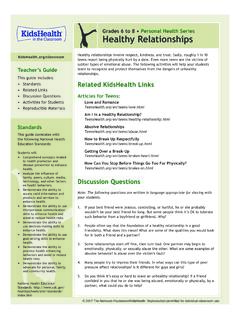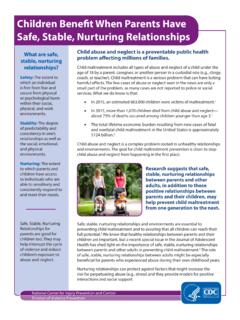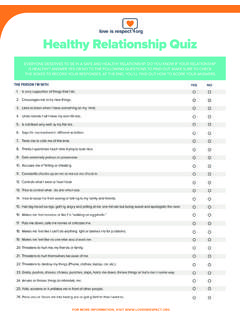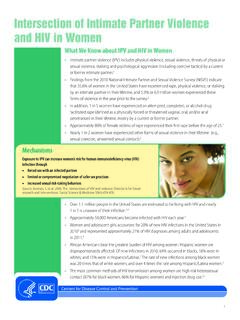Transcription of Ideas for Better Communication - Texas Christian University
1 Based on TCU Mapping-Enhanced Counseling Manuals for Adaptive Treatment As Included in NREPP Ideas FOR Better Communication A collection of materials for leading counseling sessions on ways to improve relationships through Communication N. G. Bartholomew & D. D. Simpson Texas Institute of Behavioral Research at TCU (August 2005) TCU Mapping-Enhanced Counseling manuals provide evidence-based guides for adaptive treatment services (included in the National Registry of Evidence-based Programs and Practices, NREPP, 2008). They are derived from cognitive-behavioral models designed particularly for counselors and group facilitators working in substance abuse treatment programs. Although best suited for group work, the concepts and exercises can be directly adapted to individual settings. When accompanied by user-friendly information about client assessments that measure risks, needs, and progress over time, TCU Mapping-Enhanced Counseling manuals represent focused, time-limited strategies for engaging clients in discussions and activities on important recovery topics.
2 These materials and related scientific reports are available as Adobe PDF files for free download at _____ Copyright 2005 Texas Institute of Behavioral Research at TCU, Fort Worth, Texas 76129. All rights reserved. Permission is hereby granted to reproduce and distribute copies of this manual (except reprinted passages from copyrighted sources) for nonprofit educational and nonprofit library purposes, provided that copies are distributed at or below costs and that credit for authors, source, and copyright are included on each copy. No material may be copied, downloaded, stored in a retrieval system, or redistributed for any commercial purpose without the expressed written permission of Texas Christian University . Texas Institute of Behavioral Research ii TCU ( 2005) TCU MAPPING-ENHANCED COUNSELING MANUALS FOR ADAPTIVE TREATMENT Ideas FOR Better Communication Table of Contents Part 1: Communication Roadblocks.
3 1 Description: Leader guide for group with topic notes, worksheets, handouts, and discussion questions Source: TCU / Institute of Behavioral Research. From treatment manual Straight Ahead: Transition Skills for Recovery, Part 2: Repairing Relationships .. 9 Description: Discussion activity for group with worksheets and handout Source: UCLA / Matrix Institute/NDRI/Neurobehavioral Treatment Matrix Institute: Part 3: Communication Styles .. 14 Description: Leader guide for group with topic notes, worksheets, handouts, and discussion questions Source: TCU / Institute of Behavioral Research. From treatment manual Straight Ahead: Transition Skills for Recovery, Part 4: Mapping Worksheets .. 24 Description: A set of activity worksheets for use in group discussions or individual counseling Source: TCU / Institute of Behavioral Research.
4 From treatment manual TCU Guide Maps: A Resource for Counselors, Links of Interest .. 36 Description: Links to Web sites featuring materials on improving Communication and relationships Copyright 2004; 2005 TCU Institute of Behavioral Research, Fort Worth, Texas . All rights reserved. Texas Institute of Behavioral Research iii TCU ( 2005) Part 1: Communication Roadblocks Communication Roadblocks is part of the Straight Ahead: Transition Skills for Recovery manual developed at TCU. This session features a leader s script, with notes and handouts for leading a solution-focused or strengths-based discussion of dealing with perceptions that interfere with Communication . Participants are invited to think about things they do and are aware of in others that get in the way of effective Communication . Materials for a mini-lecture highlight healthy and unhealthy reactions to Communication problems.
5 Guidelines for leading an exercise to improve listening also are included. Source: TCU / Institute of Behavioral Research. From treatment manual Straight Ahead: Transition Skills for Recovery Texas Institute of Behavioral Research 1 TCU ( 2005) Communication Roadblocks Step 1 Introduce the topic of Communication roadblocks: In this session we ll take a look at some things that contribute to Communication problems and discuss some Ideas for overcoming those difficulties. This idea of sending and receiving messages is the basis of Communication . A conversation or discussion with another person involves a series of messages sent and received by both people. A message has a verbal part (words, expressions, tone of voice) and a nonverbal part (gestures, eye contact, posture). Breakdowns can happen when we don t send a clear message or when the other person doesn t send a clear message.
6 Likewise, Communication breaks down when we don t fully understand the other person s message or when the other person doesn t fully understand our message. Communication can break down for other reasons, too. For starters, when we re under the influence of drugs or alcohol we are less able to send and receive messages clearly. Here are some other factors that can influence how well we communicate: illness, lack of sleep, lack of interest, poor self-esteem, anger and other intense emotions, distractions, boredom, and the feelings we have for the person with whom we are communicating. In today s sessions we ll look at some Ideas for improving our ability to send and receive clearer messages and avoid Communication breakdowns. Ask participants to help you make a list of Communication difficulties they have encountered.
7 Use flip chart or chalkboard to list the responses and discuss briefly using some of the following questions. What are some reasons why people don t always communicate well? What is your own personal pet peeve in Communication ? What really irritates you? Do you have any bad Communication habits you d like to break? How can you tell when you are really communicating well with someone? Texas Institute of Behavioral Research 2 TCU ( 2005) Communication Roadblocks Transition: Communicating effectively with another person is not always easy. For all of us there are roadblocks that sometimes get in the way. During the remainder of the session we ll explore some ways around the most common Communication roadblocks. Step 2 Distribute Communication Roadblocks handout (page 8). Use it to lead a discussion about common perceptions and feelings that get in the way of Communication .
8 Suggested discussion questions are included for each point on the handout. We assume people know what we re talking about. Our own thoughts and Ideas are usually very clear to us. As a result, we sometimes don t explain things well or we use words or slang that others may not understand. We ve all had experiences where we are talking about one thing, and the person we are talking with thinks we are talking about something else. This contributes to Communication problems because it leads to misunderstanding. It can also result in feelings of anger or frustration in both people. When people feel angry, frustrated, or misunderstood Communication often breaks down. What can we do to help overcome this type of roadblock? How can we help make sure people understand what we re saying? Closure point: Accept that people won t always understand what you re saying.
9 Be patient, and try not to get angry. Look for signs that your message was not understood or was taken in the wrong way. Be ready to clarify or repeat what you said in a different way. We assume people know what we re feeling (or that they should!). It s normal to want understanding and sympathy from others, but it s not helpful to assume that other people should know what we are feeling. We sometimes hear people Texas Institute of Behavioral Research 3 TCU ( 2005) Communication Roadblocks say She should have known I was upset or If he really cared he would have known I was feeling blue. The truth is no one is a mind reader. It s our responsibility to tell others what we are feeling. When we assume others know what we re feeling Communication may break down. Once again, the door is open for miscommunication and anger.
10 Also we may experience hurt feelings because the other person didn t respond the way we wanted. How can we overcome this Communication barrier? What can we do to express our feelings more clearly? Closure point: Even people who love you with all their hearts may not always know what you re feeling. Use I-statements to send a clear message about what you feel, and what you need. We don t listen very well. Listening is hard work. Sometimes we don t listen well because we get distracted by things like the television set, the radio, or the baby crying in the next room. Sometimes we get distracted by our own thoughts we begin to plan what we re going to say next while the other person is still talking. And sometimes we cut people off we interrupt them or don t let them finish their thoughts. Not listening is perhaps the biggest Communication roadblock of all.
